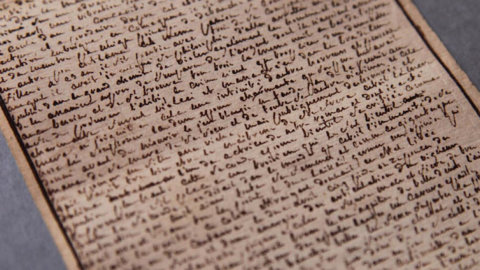The manuscript of the 120 days of Sodom by the Marquis de Sade and a series of autograph manuscripts by André Breton, including the two Manifestos of Surrealism, enter the national collections entrusted to the National Library of France. Major acquisitions follow the refusal of an export certificate in 2017 for these documents, which gives them the status of "National treasures“, and the request for patronage launched by French Ministry of Culture to make its acquisition possible. And this is how the sponsorship for the €4,55 million takeover was successful, the culture ministry said in a statement on Friday (9 July).
Protocol which allows the conservation on French territory for 30 months of goods of great patrimonial importance, the refusal of an export certificate, pronounced in 2017 after a favorable opinion from the Advisory Commission of National Treasures, for these manuscripts then allowed the State to collect the means necessary for their acquisition by the National Library of France.
Purchased by the collector Charles de Noailles in 1929, it was stolen by a publisher who sold it in 1982 to another collector, Gérard Nordmann. In 2014, it became the property of the entrepreneur Gérard Lhéritier, at the origin of the Aristophil company, which was the subject of a fraud investigation. The French government takes the opportunity of the liquidation of Aristophil to classify it as "national treasure" in 2017.
The ban on the Sade manuscript leaving the territory was decided by the Ministry of Culture primarily in consideration of its importance from the point of view of literary history: a true monument, a capital text of criticism and literature that has become a classic, has profoundly marked many authors, from André Breton to Annie Le Brun, from Georges Bataille to Pasolini.
It was locked up in the Bastille in Paris in 1785 that Sade copied this long unfinished novel in his own form, in the form of a «surprising roll of more than twelve meters in length composed of thirty-three sheets glued at the ends ending up on a width of 11,3 cm», recalls the French Ministry in a note.
It is also notable for the exceptional conditions of its production, in the Bastille on the eve of the Revolution, and for its material characteristics, an astonishing scroll over 12 meters long made up of 33 sheets glued to finish on a width of 11,3 cm. This document in every single point will join the Arsenal department of the BnF.
This manuscript will be presented at a conference in 2022, which brings together specialists and intellectuals, with the aim of questioning the figure of Sade, the reception of his work over the centuries and its reading today.
The Breton manuscripts – Soluble Poisson, the Manifeste du surréalisme and Second Manifesto of Surréalisme – constitute a remarkable collection, which brings together the essentials of the author's theoretical work. Texts of global influence, which explain the unpublished approaches of those who formed the most important literary movement of the twentieth century, join the manuscript department of the BnF, on the Richelieu site, making the library collection the richest background. those of Nadja e of magnetic fields .
They will be exhibited from July 19 in the exhibition The Invention of Surrealism, Magnetic Fields in Nadja , to the BNF François-Mitterrand.
These two important acquisitions were made thanks to the mobilization of the BnF and the Ministry of Culture, with the great support of the major patrons of the Library, thanks to the use of the tax system in favor of the acquisition of national treasures envisaged by «article 238bis 0 bis of the general tax code.
Particularly involved is the Cercle de la BnF, which since 2000 has brought together the institution's bibliophile patrons. This is how Emmanuel Boussard responded positively to the call of Jean-Claude Meyer, its president, to fully support the acquisition of the role of Sade. He wanted to demonstrate his particular attachment to the Arsenale library, of which his grandfather held the position of curator between 1943 and 1964.
The acquisition of the Breton manuscripts was carried out under the patronage of Jean-Claude Meyer, Alain Minc, Fondation Khôra – Institut de France and Carlo Perrone. The latter is also delighted to see the manuscript of Sade, which belonged to his grandparents Charles and Marie-Laure de Noailles, enter public collections. The sale of this ensemble was carried out through the bankruptcy trustee in charge of the Aristophil fund, with the collaboration of the Aguttes auction house.
This exceptional enrichment of the national collections is one of the most important in recent years for the BnF. The Ministry of Culture and the National Library of France thank the patrons who contributed to the realization of these acquisitions.





